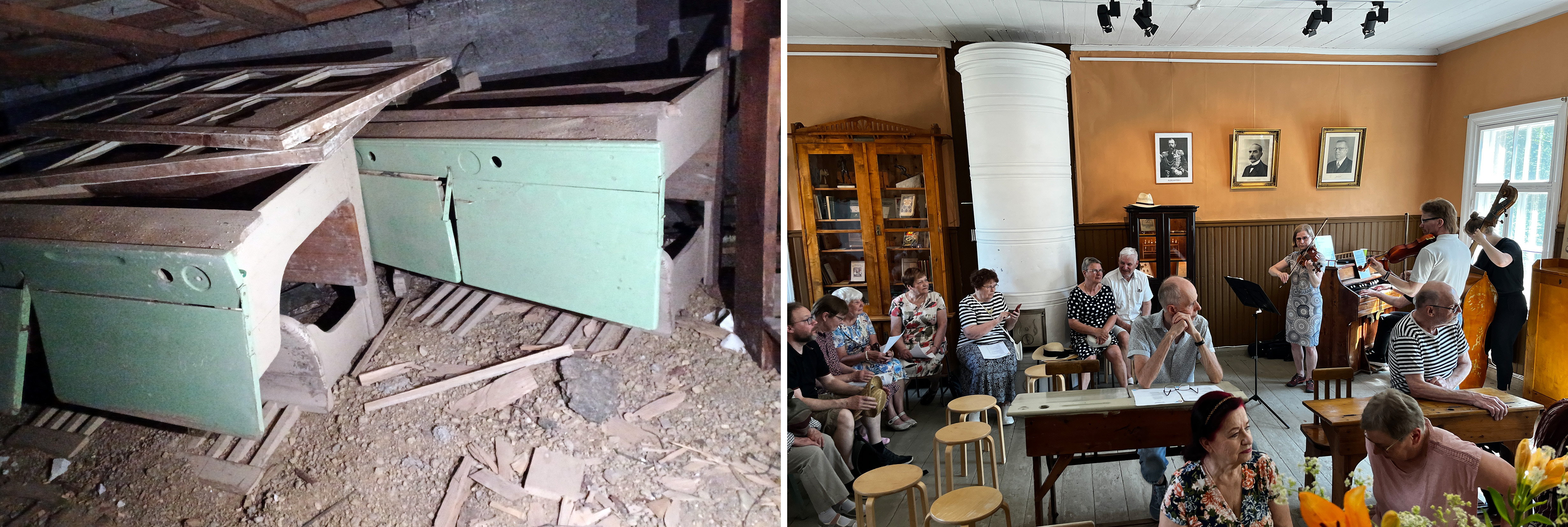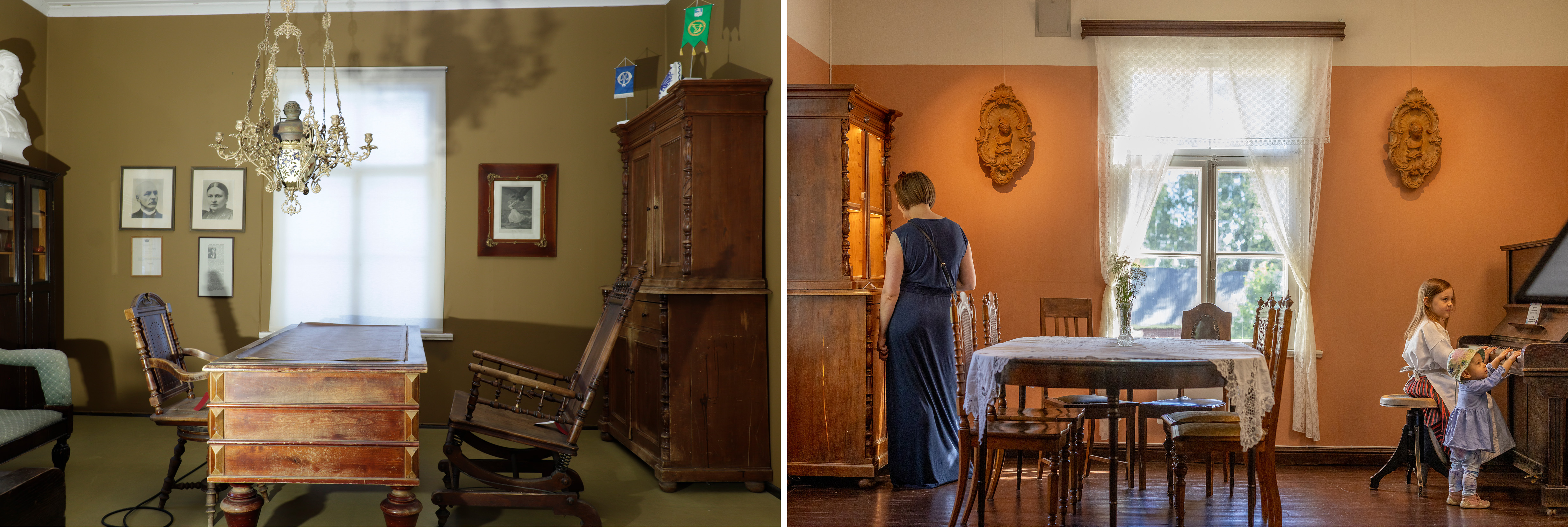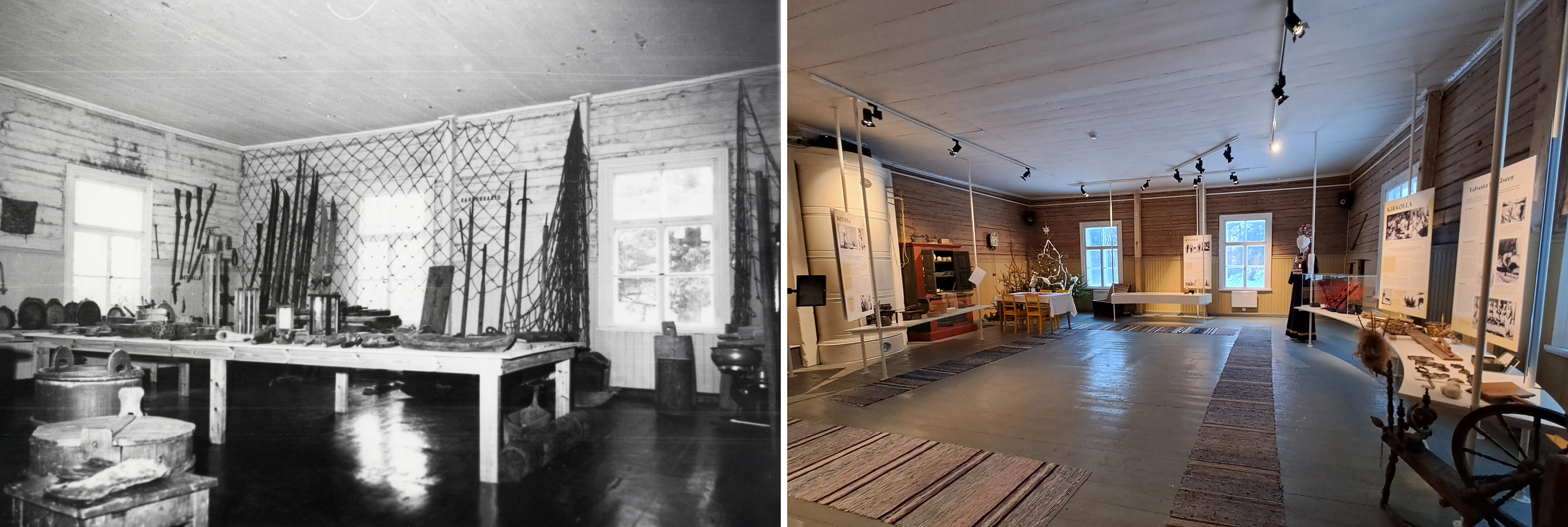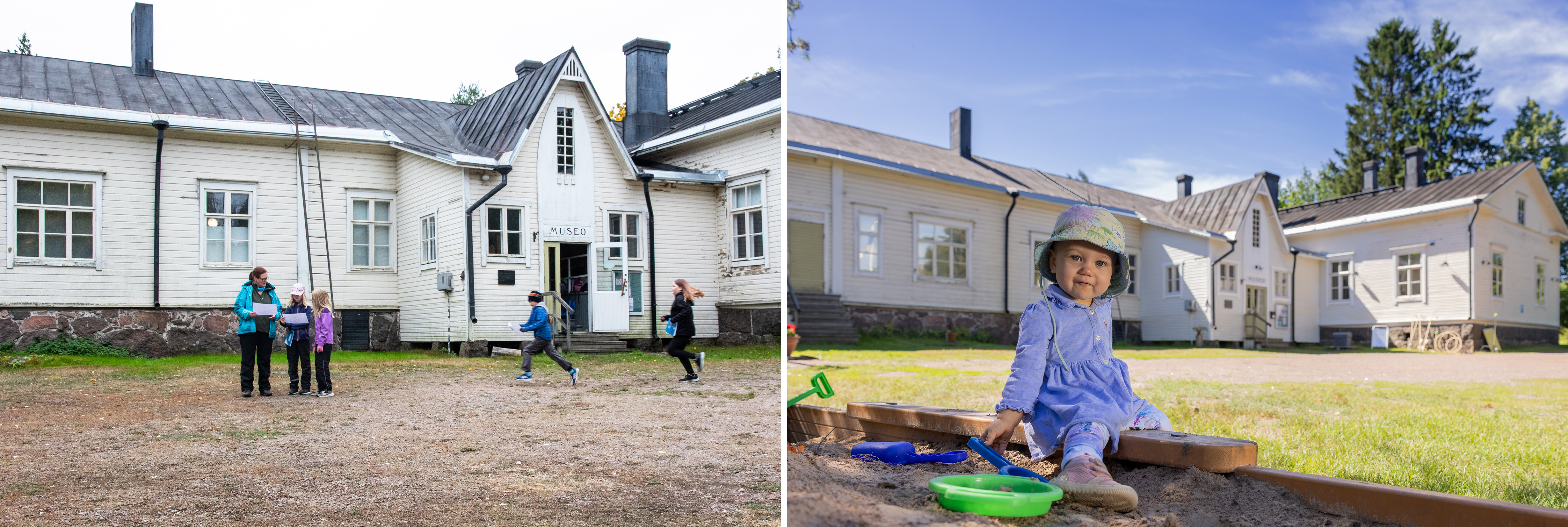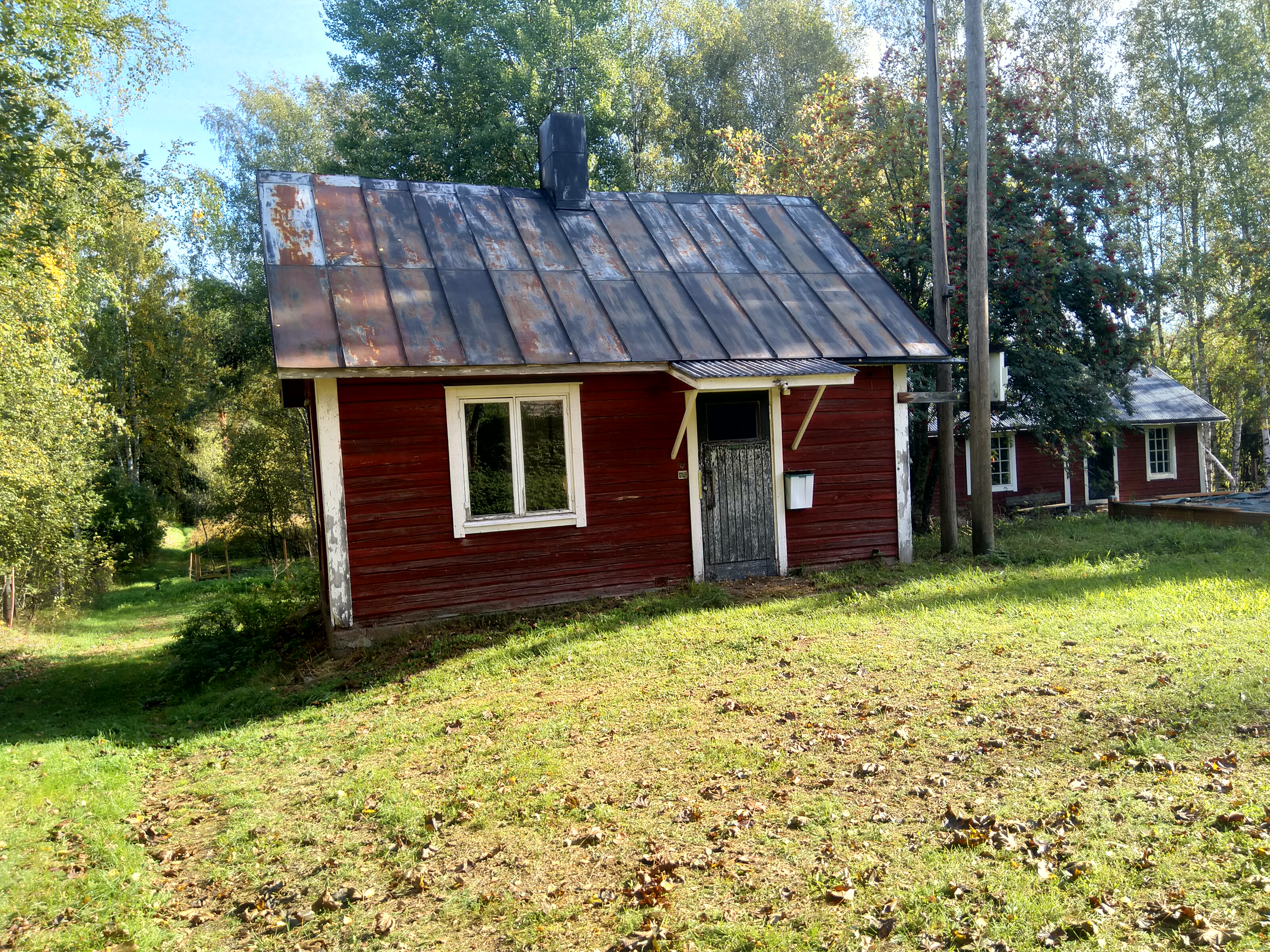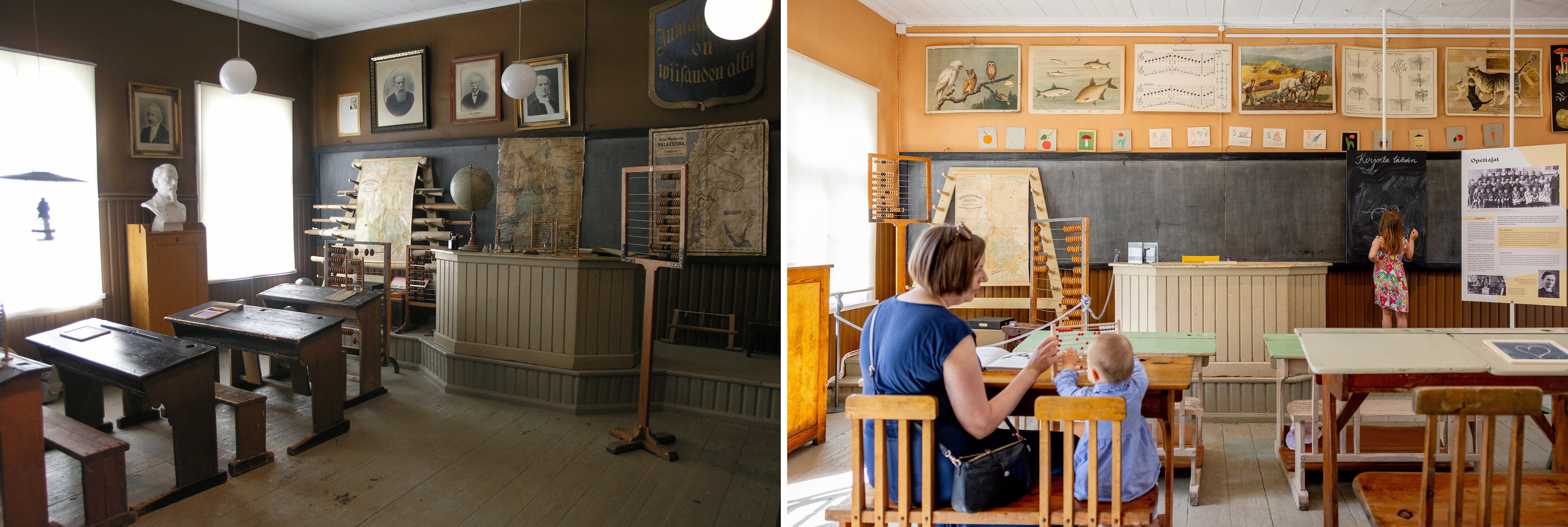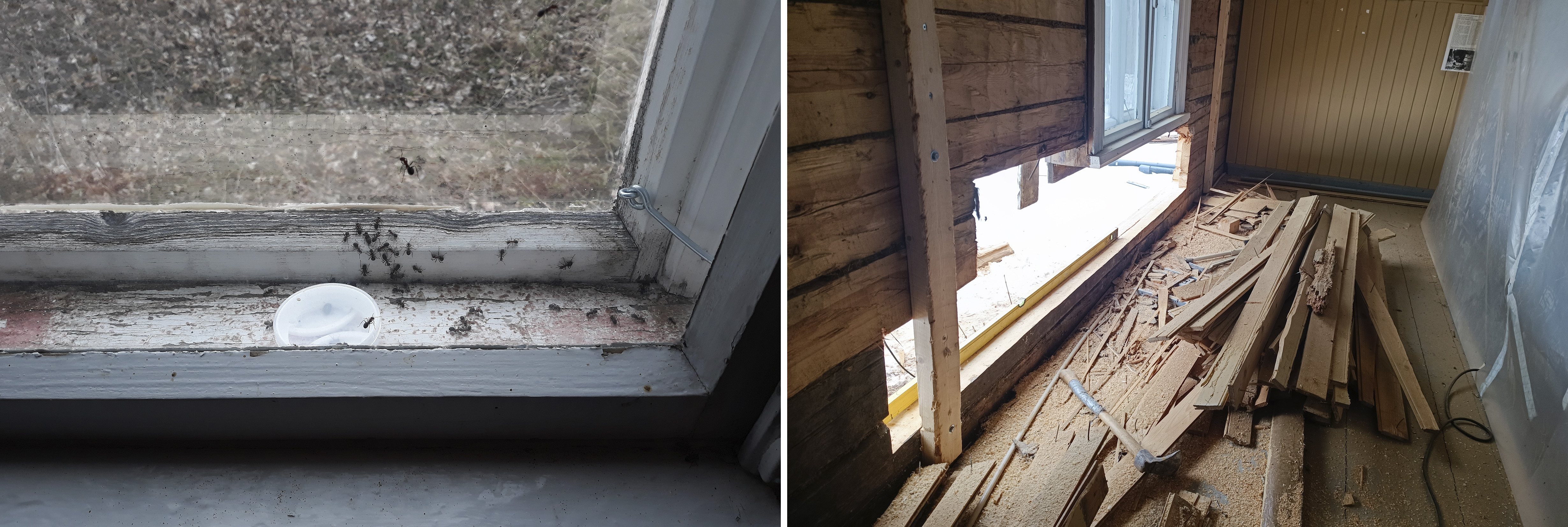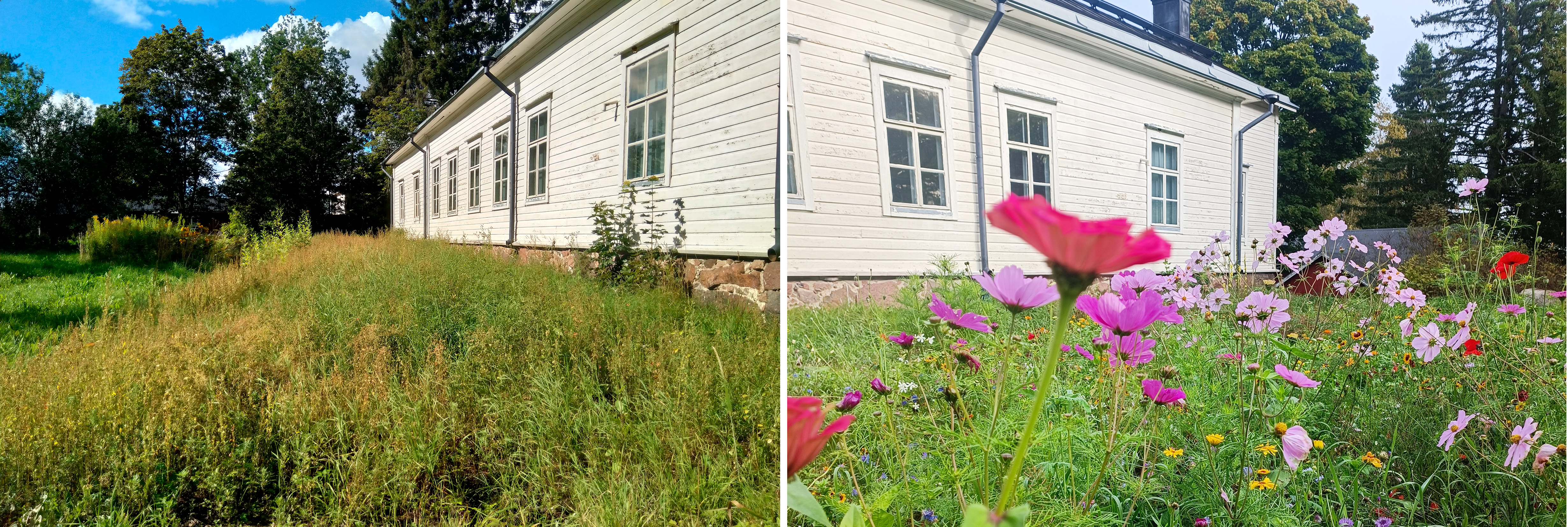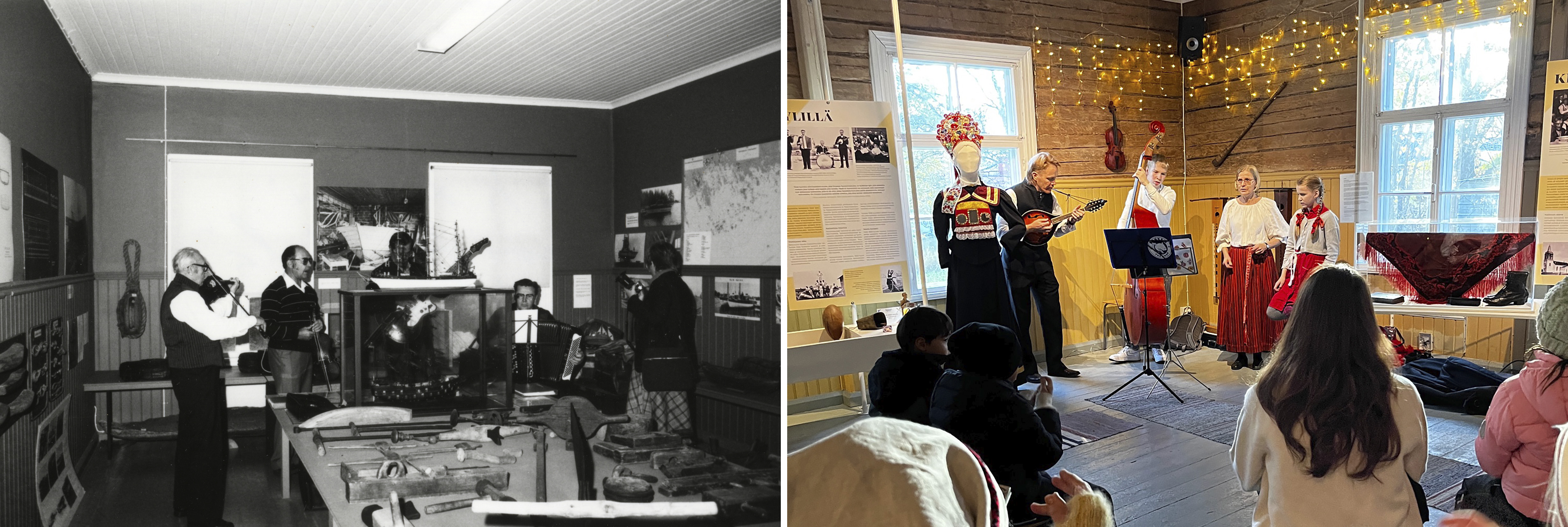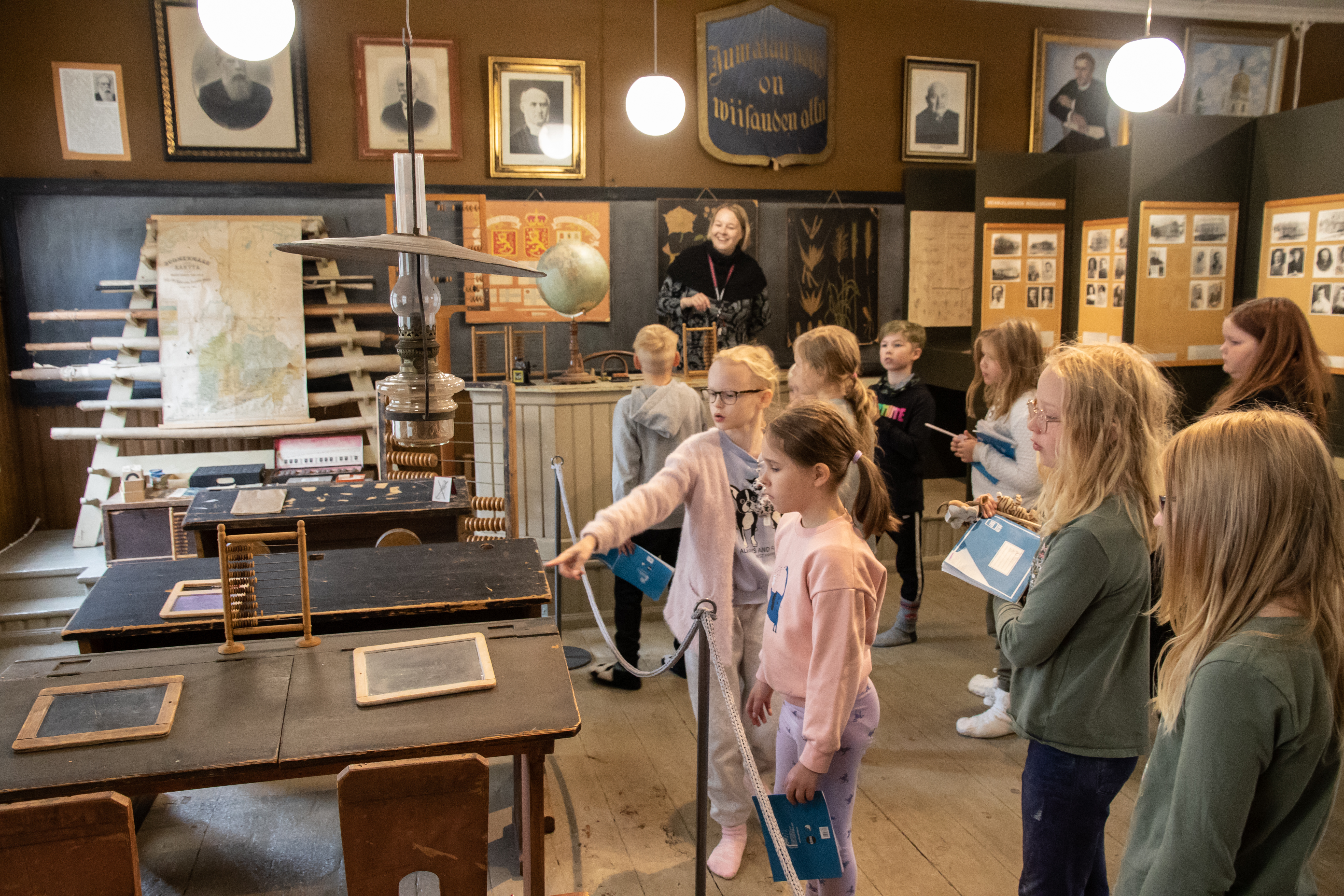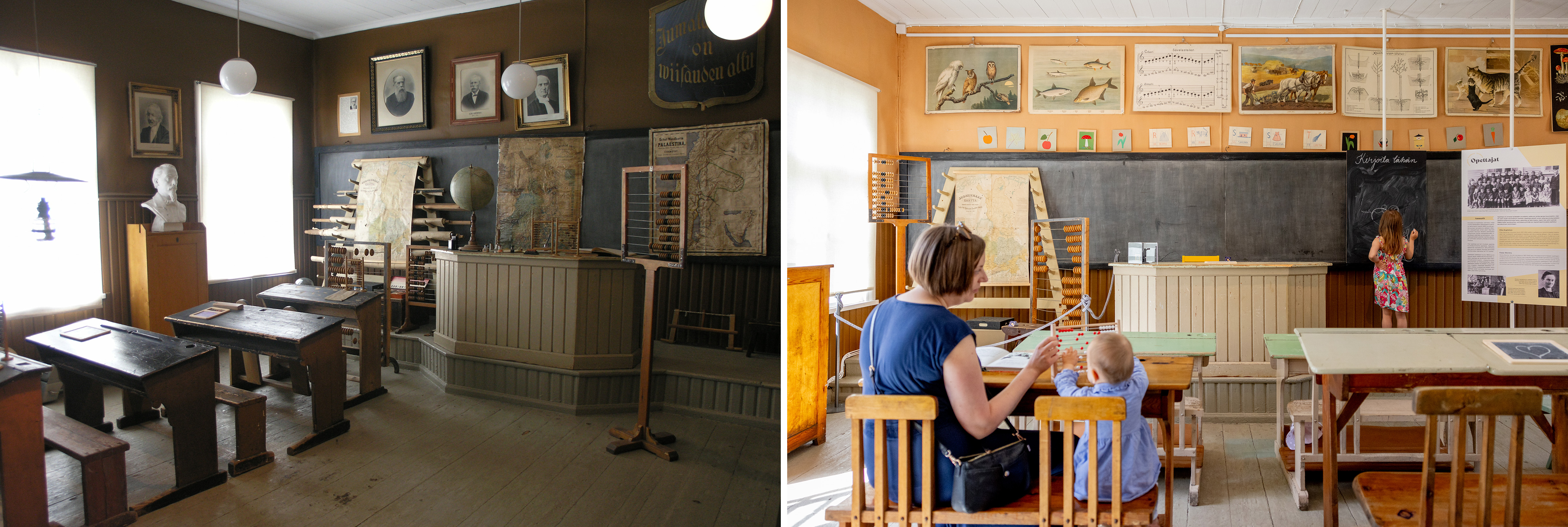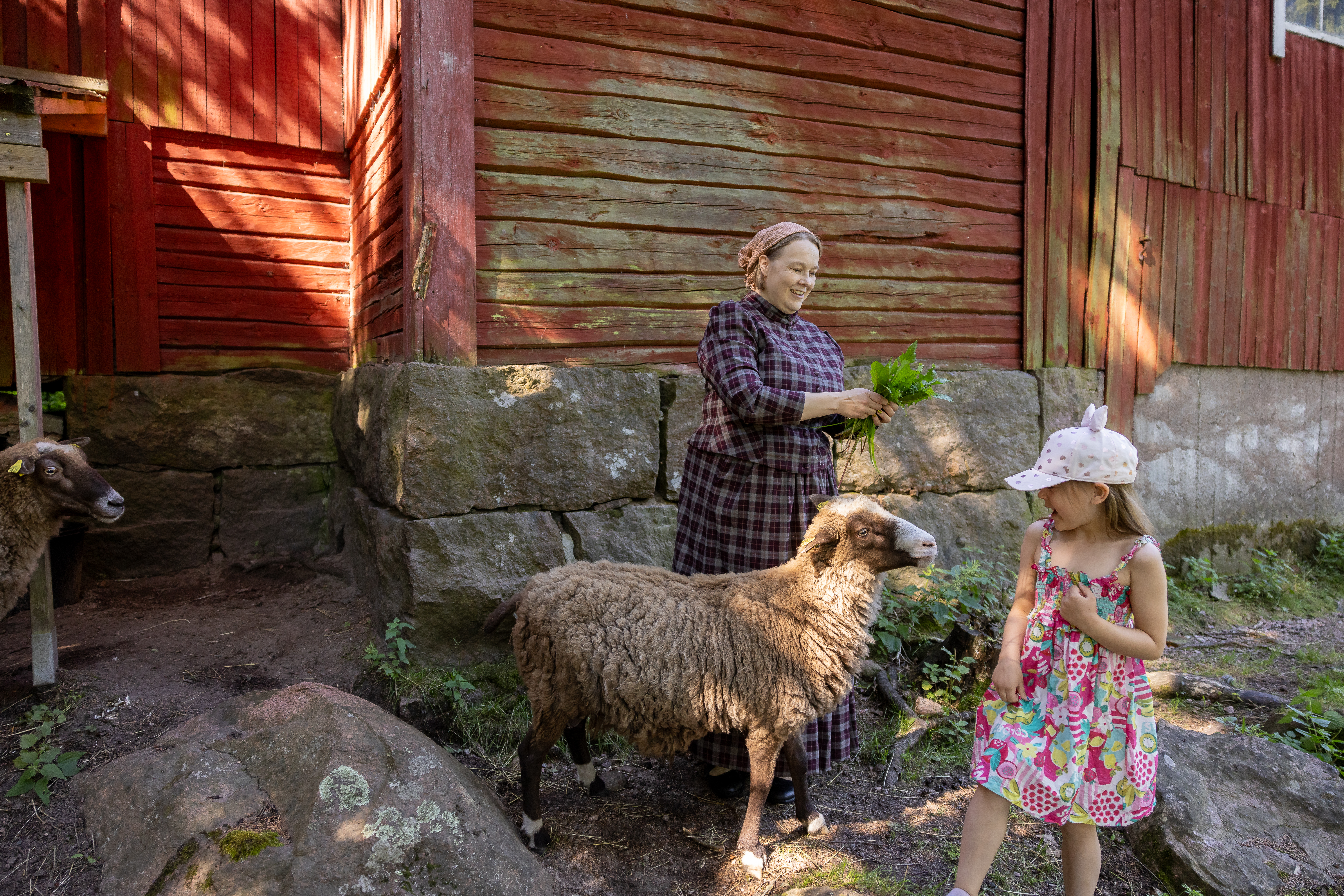Regenerative Revival of Local Museum
Regenerative Revival of Vehkalahti Local Museum
The need for the revival of the Vehkalahti Local Museum arose from the poor condition of its old, culturally significant building. Envisioned as a space for local communities' self-driven activities, the museum reflects the city's commitment to ecological and inclusive values. The 2003 merging of Vehkalahti with Hamina emphasized the importance of keeping the name alive, fostering local pride. The renovation also offered a chance to refresh the museum's exhibition.
Finland
Kuninkaantie 3, 49510 Husula (Hamina), Finland
Prototype level
Yes
Yes
Yes
No
No
075: Fredrikshamn (FI)
The need for the regenerative revival of the Vehkalahti local museum arose from two main starting points: the poor condition of the valuable historical building, and the need to completely renew the old museum exhibition to answer the needs and questions of today’s museum visitor. From humble beginnings the project grew through its implementation to draw together the restoration of historical buildings, inclusion of the community in different ways through the process and beyond, and ecological thinking.
The overall aim of the project was to rejuvenate the old local museum to appeal and influence modern audiences, including different user groups both local and from further afield. We wanted to create a museum where everyone would feel welcome, and which would serve also as a space for various forms of artistic expression and other small events both public and even private.
The upkeep of museums is costly, and through enabling the use of the museum space for multiple purposes, all of which need not be related to the workings of the museum per se, we wanted to create a place where people could feel belonging and inclusion. The specific groups we aimed the renewal for were families with kids, and schools and kindergartens, which are an important visitor group of our museums in general and this museum in particular. Another important group are local residents, especially from the villages of the former parish of Vehkalahti. Their ancestors have donated most of the objects in the museum collection and some elderly locals have also gone to school in the building. These people feel emotional attachment to the museum.
The overall aim of the project was to rejuvenate the old local museum to appeal and influence modern audiences, including different user groups both local and from further afield. We wanted to create a museum where everyone would feel welcome, and which would serve also as a space for various forms of artistic expression and other small events both public and even private.
The upkeep of museums is costly, and through enabling the use of the museum space for multiple purposes, all of which need not be related to the workings of the museum per se, we wanted to create a place where people could feel belonging and inclusion. The specific groups we aimed the renewal for were families with kids, and schools and kindergartens, which are an important visitor group of our museums in general and this museum in particular. Another important group are local residents, especially from the villages of the former parish of Vehkalahti. Their ancestors have donated most of the objects in the museum collection and some elderly locals have also gone to school in the building. These people feel emotional attachment to the museum.
restoration
platform
ecological
inclusion
museums
We prefer to preserve old buildings over constructing new ones. The over 150-years-old timber-built house has the potential to stand for another 150 years, if it is properly cared for, and over its lifespan it has more than made up for its carbon footprint.
We do not aim for optimal conditions for the museum objects, but to acceptable conditions which will not compromise the preservation of the object but reduce the need for energy consumption. The building does not have air-conditioning. In winter, when the seasonally open museum is not visited, the heating is turned to a lower temperature. These choices mean that all types of objects cannot be displayed in the Vehkalahti village museum, but we have other museum spaces for that.
We work to reduce the ecological footprint of our museum practices. We source our materials mainly locally and regionally and use environmentally friendly and recyclable materials. We introduced a strict recycling program, which starts from avoiding unnecessary waste and continues to the proper sorting and responsible disposal of it. To reduce energy consumption, all electric cables and lighting were redone and led lights were introduced. The electric appliances are at minimum A-level for energy consumption. Instead of getting all new, old, durable wooden furniture was repurposed. The property did not have plumbing or piping, and those were not installed. Instead, we introduced a modern, composting dry toilet on the premises.
Our third aim is to protect and enhance biodiversity. We keep sheep to maintain traditional, wooded grazing land, which offers conditions for certain plants and insects. Working with a local beekeeper, we introduced beehives to protect pollinators. We also give examples of how people can help through their own actions, e.g., we do not use chemical fertilizers, weedkillers or pesticides. Future work includes a gardening scheme to maintain biodiversity and a biodiversity survey of the area.
We do not aim for optimal conditions for the museum objects, but to acceptable conditions which will not compromise the preservation of the object but reduce the need for energy consumption. The building does not have air-conditioning. In winter, when the seasonally open museum is not visited, the heating is turned to a lower temperature. These choices mean that all types of objects cannot be displayed in the Vehkalahti village museum, but we have other museum spaces for that.
We work to reduce the ecological footprint of our museum practices. We source our materials mainly locally and regionally and use environmentally friendly and recyclable materials. We introduced a strict recycling program, which starts from avoiding unnecessary waste and continues to the proper sorting and responsible disposal of it. To reduce energy consumption, all electric cables and lighting were redone and led lights were introduced. The electric appliances are at minimum A-level for energy consumption. Instead of getting all new, old, durable wooden furniture was repurposed. The property did not have plumbing or piping, and those were not installed. Instead, we introduced a modern, composting dry toilet on the premises.
Our third aim is to protect and enhance biodiversity. We keep sheep to maintain traditional, wooded grazing land, which offers conditions for certain plants and insects. Working with a local beekeeper, we introduced beehives to protect pollinators. We also give examples of how people can help through their own actions, e.g., we do not use chemical fertilizers, weedkillers or pesticides. Future work includes a gardening scheme to maintain biodiversity and a biodiversity survey of the area.
A space that appears undervalued does not invite visitors to feel appreciated, nor does it inspire pride in the staff presenting it. The building was in poor condition. Signs of neglect were evident – leaks, rot, paint flaking off. However, we saw potential for something beautiful: a well-built house with stunning natural light.
The building has a dual history as a school and as a museum. Restoration to a specific moment in time was neither practical nor desirable. Instead, we chose to preserve the spirit of the building through its colors, textures, and finishes. We transformed an old house into a museum while respecting its history and atmosphere.
Demolition and rebuilding were kept to a minimum. When wallpaper was peeling, a fragment was preserved or a sample saved. Peeling was reattached, sealed, and painted, leaving all layers intact for future discovery. Interior colours were chosen from historical layers but adapted for modern use. In areas where we lacked the resources to do things properly, we chose to do nothing for now.
We selected breathable, predominantly VOC-free paints. Clay-based paints provided the same texture and feel as the old hide-glue-based paints, being also animal-friendly while being non-toxic. When oil-based products were necessary, we sourced them from a local vendor to ensure they contained no fungicides. Rotted logs were replaced only as much as needed, and leaky window frames were repaired to prevent further deterioration.
A house is never truly finished, it evolves as people use it; materials age and needs shift. The goal is not to freeze in time but to create a living museum, where history and practicality meet. The renovation work will continue according to these principles. Completing the unfinished and maintenance will be key. The choices we made – avoiding irreversible changes, and preserving historical layers – ensure that future caretakers can continue the work without being locked into a single vision.
The building has a dual history as a school and as a museum. Restoration to a specific moment in time was neither practical nor desirable. Instead, we chose to preserve the spirit of the building through its colors, textures, and finishes. We transformed an old house into a museum while respecting its history and atmosphere.
Demolition and rebuilding were kept to a minimum. When wallpaper was peeling, a fragment was preserved or a sample saved. Peeling was reattached, sealed, and painted, leaving all layers intact for future discovery. Interior colours were chosen from historical layers but adapted for modern use. In areas where we lacked the resources to do things properly, we chose to do nothing for now.
We selected breathable, predominantly VOC-free paints. Clay-based paints provided the same texture and feel as the old hide-glue-based paints, being also animal-friendly while being non-toxic. When oil-based products were necessary, we sourced them from a local vendor to ensure they contained no fungicides. Rotted logs were replaced only as much as needed, and leaky window frames were repaired to prevent further deterioration.
A house is never truly finished, it evolves as people use it; materials age and needs shift. The goal is not to freeze in time but to create a living museum, where history and practicality meet. The renovation work will continue according to these principles. Completing the unfinished and maintenance will be key. The choices we made – avoiding irreversible changes, and preserving historical layers – ensure that future caretakers can continue the work without being locked into a single vision.
The whole renovation and exhibition process has been one aiming for inclusion of local residents and different user groups from the planning through the renovation, maintenance and use of the premises. Our aim was to create a museum which serves also as a platform for different activities of local societies, groups and individuals. The museum acts as a companion and enabler for various unprompted activities of the local community.
The museum area is freely accessible and can be used for recreation all times. We keep our ticket prices for adults relatively low (6 € in 2025) and offer reduced prices for, e.g., pensioners and unemployed. Youth and children under 18 years of age have free entrance, and guided tours for kindergartens, schools and other educational institutions are free. In co-operation with Kymenlaakso region health and social services, we also offer free entrance to socially or economically disadvantaged people. All museum events are free of charge or low-cost, and entrance is free to everyone on every opening Wednesday to ensure that everyone can visit the museum and participate in its activities.
Making a protected historical building accessible is not an easy task, and our first idea for providing an accessible entrance to wheelchair-users, while preserving the historical integrity of the building, didn’t work out, proving to be both too costly and too invasive on the building. We are currently working on different options for solving the problem. In the museum area, where the various outbuildings such as a functioning smithy are located, we have wheelchair access, and the toilet is accessible by wheelchair. The touchable objects in the museum also suit people with visual impairment or other disabilities. Holding an object, and knowing other people have been using it a hundred years ago, can be a powerful experience for everyone in the way it physically connects us to the past generations.
The museum area is freely accessible and can be used for recreation all times. We keep our ticket prices for adults relatively low (6 € in 2025) and offer reduced prices for, e.g., pensioners and unemployed. Youth and children under 18 years of age have free entrance, and guided tours for kindergartens, schools and other educational institutions are free. In co-operation with Kymenlaakso region health and social services, we also offer free entrance to socially or economically disadvantaged people. All museum events are free of charge or low-cost, and entrance is free to everyone on every opening Wednesday to ensure that everyone can visit the museum and participate in its activities.
Making a protected historical building accessible is not an easy task, and our first idea for providing an accessible entrance to wheelchair-users, while preserving the historical integrity of the building, didn’t work out, proving to be both too costly and too invasive on the building. We are currently working on different options for solving the problem. In the museum area, where the various outbuildings such as a functioning smithy are located, we have wheelchair access, and the toilet is accessible by wheelchair. The touchable objects in the museum also suit people with visual impairment or other disabilities. Holding an object, and knowing other people have been using it a hundred years ago, can be a powerful experience for everyone in the way it physically connects us to the past generations.
In the planning stage, we involved all the pupils and teachers from Husula school to develop the museum. Pupils worked on their ideas in small groups and their discussions were recorded. Popular ideas were included in the plan of the new exhibition. Ca. 50 pupils also filled in the Internet questionnaire aimed for the general public, to ensure we have covered the opinions of children. The Town of Hamina is currently aiming for the UNESCO Child Friendly Cities status, and the museums have been one of the pioneers.
Locals were involved in the planning stage through an open Internet questionnaire, which received 91 answers. Then we made an open invitation for locals to bring up their questions and opinions and arranged two open meetings at the museum to discuss with people.
Both children and adults were asked to name their favourite exhibits, to make sure that the most loved objects would be present in the new exhibition as well. Since many objects in the museum were donated by the locals, older people still recognise them, know their stories, and feel a strong connection to them.
Through our work it became clear that the museum was significant for the identity for people from the villages of the former Vehkalahti Parish area, now part of Hamina. Thus it was obvious that “Vehkalahti” should be preserved in the new name for the museum. From people’s suggestions, we formulated three options, of which Vehkalahti Village Museum (Vehkalahden Kylämuseo) was the most popular. The name underlines the connection with the people of the former Vehkalahti Parish.
We wanted to create a museum space which also serves as a platform for the local community, and we have succeeded in our aim. The museum has been used for society meetings and workshops. The first art exhibition will take place in the summer of 2025. We often work in partnerships: our users offer some content for our visitors in return for using the premises, which enriches our museum’s activities.
Locals were involved in the planning stage through an open Internet questionnaire, which received 91 answers. Then we made an open invitation for locals to bring up their questions and opinions and arranged two open meetings at the museum to discuss with people.
Both children and adults were asked to name their favourite exhibits, to make sure that the most loved objects would be present in the new exhibition as well. Since many objects in the museum were donated by the locals, older people still recognise them, know their stories, and feel a strong connection to them.
Through our work it became clear that the museum was significant for the identity for people from the villages of the former Vehkalahti Parish area, now part of Hamina. Thus it was obvious that “Vehkalahti” should be preserved in the new name for the museum. From people’s suggestions, we formulated three options, of which Vehkalahti Village Museum (Vehkalahden Kylämuseo) was the most popular. The name underlines the connection with the people of the former Vehkalahti Parish.
We wanted to create a museum space which also serves as a platform for the local community, and we have succeeded in our aim. The museum has been used for society meetings and workshops. The first art exhibition will take place in the summer of 2025. We often work in partnerships: our users offer some content for our visitors in return for using the premises, which enriches our museum’s activities.
The Town of Hamina funded the budget for the renovation of the old school building and the building of the new museum exhibition in 2022–23 as well as the continuation of the work in 2024. We got a nominal grant of 2000 euros from the regional Centre for Economic Development, Transport and the Environment in 2023. The Town of Hamina also covers the continuous maintenance of the buildings, salaries of the personnel and other running costs from the annual budgets allocated for the museums.
The renovation of interior spaces was done by Rannikkopajat (workshop initiative that provides unemployed young people with the opportunity to develop work-life and daily management skills), working with the guidance of the museum staff and two conservator-restorers. A deliberate choice was made to give the group significant responsibility for the project's progress. Help and advice were always available, but the work remained their own.
The personnel of the regional Kymenlaakson Museum, and the Finnish Heritage Agency, who are responsible for the preservation of cultural heritage, have been involved in the planning and execution of the renovation as expert consultants. They include architects and specialists in the preservation and restoration of historical buildings.
The renovation of interior spaces was done by Rannikkopajat (workshop initiative that provides unemployed young people with the opportunity to develop work-life and daily management skills), working with the guidance of the museum staff and two conservator-restorers. A deliberate choice was made to give the group significant responsibility for the project's progress. Help and advice were always available, but the work remained their own.
The personnel of the regional Kymenlaakson Museum, and the Finnish Heritage Agency, who are responsible for the preservation of cultural heritage, have been involved in the planning and execution of the renovation as expert consultants. They include architects and specialists in the preservation and restoration of historical buildings.
We involved professionals from museum pedagogy, conservation, restoration, architecture, and traditional building methods. Our approach was two-pronged: The conservative restoration of the building and the inclusive planning of the new exhibition.
Our chief conservator, an experienced restoration professional, led the restoration. They coordinated the professionals working on the structural repairs and worked in collaboration with the coach of Rannikkopajat youth workshop. The professionals of architecture and management of historic buildings from the Kymenlaakso Museum and Finnish Heritage Agency gave consultations. The most rewarding outcome was the team formed between professionals and youth during the project.
Our curator was responsible for the inclusive planning. She made questionnaires, held workshops with pupils and met with the locals. The contributions from these audiences were indispensable, highlighting the significance of the museum for the locals’ identity. We wanted to preserve the locals’ sense of ownership for the museum by respecting their opinions and including their contributions. The accessible museum furniture was planned by architects, while a local carpenter repurposed the old furniture.
The old exhibition was very object-heavy. While the objects were familiar to the older generation, it was puzzling to children. To bridge this gap, we added texts and photos of village life, often sparking discussions as locals recognize their relatives. This turns museum visits into shared experiences where knowledge and memories are exchanged. Reducing the number of exhibits has met some critique. As a future action, we aim to include more information about the objects’ origin and users. We plan to have open meetings with the locals to enrich the information about the exhibits, in a similar manner to the repatriation of indigenous objects. The recognition of the former owners and users is a way of giving them back to the local people.
Our chief conservator, an experienced restoration professional, led the restoration. They coordinated the professionals working on the structural repairs and worked in collaboration with the coach of Rannikkopajat youth workshop. The professionals of architecture and management of historic buildings from the Kymenlaakso Museum and Finnish Heritage Agency gave consultations. The most rewarding outcome was the team formed between professionals and youth during the project.
Our curator was responsible for the inclusive planning. She made questionnaires, held workshops with pupils and met with the locals. The contributions from these audiences were indispensable, highlighting the significance of the museum for the locals’ identity. We wanted to preserve the locals’ sense of ownership for the museum by respecting their opinions and including their contributions. The accessible museum furniture was planned by architects, while a local carpenter repurposed the old furniture.
The old exhibition was very object-heavy. While the objects were familiar to the older generation, it was puzzling to children. To bridge this gap, we added texts and photos of village life, often sparking discussions as locals recognize their relatives. This turns museum visits into shared experiences where knowledge and memories are exchanged. Reducing the number of exhibits has met some critique. As a future action, we aim to include more information about the objects’ origin and users. We plan to have open meetings with the locals to enrich the information about the exhibits, in a similar manner to the repatriation of indigenous objects. The recognition of the former owners and users is a way of giving them back to the local people.
We fearlessly involved different parts of the public from the beginning of the initiative, starting from the planning of the exhibition, and did not restrict their participation into a certain theme or space only. Some choices and pick-ups of objects to exhibit would probably not have been made by museum professionals, but we wanted to respect the voices of children and adults alike.The restoration work and repairs were treated as a chance for education and learning through the involvement of the Rannikopajat youth vocational rehabilitation. The conscious decision to give responsibility to the youngsters worked out, giving them the opportunity to feel pride and accomplishment in their own work – something everyone needs. Museums are increasingly aware of their ecological footprint, especially the energy used for climate-controlled spaces. At Vehkalahti Village Museum, we have implemented economical and ecological solutions for adapting museum spaces. The idea is that since the objects have been in the same environment for so long, they have adjusted to the conditions, reaching their natural limits of expansion and contraction. As a result, no significant additional harm occurs to organic materials.
The most innovative outcome of our initiative is to provide a living and breathing museum space, which also functions as a platform for the local community. We trust people’s understanding of their own history and their appreciation of it. We let them engage with the objects of their own history even without the watchful eye of museum staff. Associations and communities are guided on how to operate in our spaces in a way that protects museum objects. We currently work with several societies, individuals and loose organisations, to offer a variety of activities, which are produced by the local people. The museums and other services of the Town of Hamina work as partners and companions, arranging funding or other needed facilities, but the initiative comes from the people.
The most innovative outcome of our initiative is to provide a living and breathing museum space, which also functions as a platform for the local community. We trust people’s understanding of their own history and their appreciation of it. We let them engage with the objects of their own history even without the watchful eye of museum staff. Associations and communities are guided on how to operate in our spaces in a way that protects museum objects. We currently work with several societies, individuals and loose organisations, to offer a variety of activities, which are produced by the local people. The museums and other services of the Town of Hamina work as partners and companions, arranging funding or other needed facilities, but the initiative comes from the people.
From the start, the three overarching approaches of our initiative were the conservative repairs and preservation of the historical building, inclusion of the local public from the planning stage of the exhibition through the current use of the building, and ecological thinking in developing both the premises and the wider location.
We have been working with an old building with the principles of conservation, maintaining the objective of not making any non-reversible changes to the building while taking care of necessary structural repairs, preserving layers of history rather than opting for rigid restoration. Through our work we want to enhance the appreciation for historical buildings, working methods, everyday practices and materials, which are often more environmentally-friendly than our modern day materials and techniques.
As a local museum operative, our main objective is to give people materials and tools for building their own identities and growing roots in Hamina, the wider Kymenlaakso region and in Finland. Through highlighting the past we want to bring forth the understanding that people, their needs, feelings and aspirations, have not essentially changed in time, and produce an environment that invites people to experience the materiality of the past in the present. Our approach is to empower the people to express themselves, to encourage them to take responsibility for their actions and our shared environment, and to help them find their own place in the present and future.
We have been working with an old building with the principles of conservation, maintaining the objective of not making any non-reversible changes to the building while taking care of necessary structural repairs, preserving layers of history rather than opting for rigid restoration. Through our work we want to enhance the appreciation for historical buildings, working methods, everyday practices and materials, which are often more environmentally-friendly than our modern day materials and techniques.
As a local museum operative, our main objective is to give people materials and tools for building their own identities and growing roots in Hamina, the wider Kymenlaakso region and in Finland. Through highlighting the past we want to bring forth the understanding that people, their needs, feelings and aspirations, have not essentially changed in time, and produce an environment that invites people to experience the materiality of the past in the present. Our approach is to empower the people to express themselves, to encourage them to take responsibility for their actions and our shared environment, and to help them find their own place in the present and future.
The process of involving locals from different age groups in the planning stage can be easily transferred and replicated in other locations and initiatives, focussing on the groups recognized as relevant for the initiative. Also our idea that the museum works not only as an exhibition but as a collective space for gatherings, various activities and art, is highly transferable and replicable. From the renovation phase, the principles of local unemployed youth working and learning side by side with professionals of the field, is likewise transferable and can be easily fitted to suit local conditions as an educational and empowering initiative for relevant social groups.
We have been working with an old building with the principles of conservation, maintaining the objective of not making any non-reversible changes to the building while taking care of necessary structural repairs. The method of repurposing colors, textures, and gloss values, along with the ambiance of a place, while preserving layers of history rather than opting for rigid restoration is an affordable way to maintain a building’s character, and a recommendable one. Attention has been given to the ecological impact and wholesomeness of the materials chosen – these two are often supportive of each other.
Finally, our aim is not to preach about our ecological values but to distill them to our visitors through our own example, by showing small, easy and affordable steps how everyone can enhance the diversity and preservation of nature in their everyday lives. This approach is also reflected in our own activities aimed for the public, offering a range of events from a day dedicated to the renovation of old buildings (May 2024) to cooking a vegetarian dinner from local ingredients and eating together (coming in August 2025). This approach of “do as I do” is cost-effective and can be replicated in different scales and for different environments.
We have been working with an old building with the principles of conservation, maintaining the objective of not making any non-reversible changes to the building while taking care of necessary structural repairs. The method of repurposing colors, textures, and gloss values, along with the ambiance of a place, while preserving layers of history rather than opting for rigid restoration is an affordable way to maintain a building’s character, and a recommendable one. Attention has been given to the ecological impact and wholesomeness of the materials chosen – these two are often supportive of each other.
Finally, our aim is not to preach about our ecological values but to distill them to our visitors through our own example, by showing small, easy and affordable steps how everyone can enhance the diversity and preservation of nature in their everyday lives. This approach is also reflected in our own activities aimed for the public, offering a range of events from a day dedicated to the renovation of old buildings (May 2024) to cooking a vegetarian dinner from local ingredients and eating together (coming in August 2025). This approach of “do as I do” is cost-effective and can be replicated in different scales and for different environments.
In our own environment we address the following global challenges in the local level:
Combating the loss of biodiversity
– Positively contributing with sheep grazing to promote traditional habitats and beekeeping to preserve pollinators, which are vital for food production.
– Maintenance plan and biodiversity survey to preserve local biodiversity (work in progress).
Resources – Sustainable building and museum practices
– Promoting a mindset that values preservation over demolition, highlighting that restoring existing buildings is often more sustainable than rebuilding, both for heritage and the environment.
– Recycling and reuse of materials starting from the planning stage; choosing ecological, durable, renewable, reusable and recyclable materials.
Energy – Energy efficient museum conditions
– Promoting acceptable museum conditions instead of optimal to save energy on heating and air conditioning, reducing our energy consumption and carbon footprint which feed climate change.
Through these initiatives, we integrate local action with global responsibility, demonstrating that small-scale efforts can help build a more sustainable future.
Combating the loss of biodiversity
– Positively contributing with sheep grazing to promote traditional habitats and beekeeping to preserve pollinators, which are vital for food production.
– Maintenance plan and biodiversity survey to preserve local biodiversity (work in progress).
Resources – Sustainable building and museum practices
– Promoting a mindset that values preservation over demolition, highlighting that restoring existing buildings is often more sustainable than rebuilding, both for heritage and the environment.
– Recycling and reuse of materials starting from the planning stage; choosing ecological, durable, renewable, reusable and recyclable materials.
Energy – Energy efficient museum conditions
– Promoting acceptable museum conditions instead of optimal to save energy on heating and air conditioning, reducing our energy consumption and carbon footprint which feed climate change.
Through these initiatives, we integrate local action with global responsibility, demonstrating that small-scale efforts can help build a more sustainable future.
In coming years, we will continue work with the museum building, the exhibition and enhancing biodiversity in the premises. Meanwhile, through all development and restoration work, the museum will continue to work as an inclusive community platform.
Restoration work in the main building will continue to transform it into an aesthetically pleasing and healthy space and preserve it to future generations. In 2023–24 we managed to restore ca. ⅔ of the main building, but its eastern part, built ca. 1915, is waiting for repairs. Currently, the east part is closed to the public because of poor air quality and potential structural damage. In 2025, air vents will be added to the foundations and in the rooms above, to enhance circulation and air quality. We will study the structural condition to determine the necessary repairs following the principles of conservative restoration, and seek external funding. We also work to solve the issue of accessible entrance. The exterior painting of the main building will take place in 2027. Structural repairs will be determined based on the results of the work in 2025–26.
When the east part of the main building has been restored, we will extend the museum exhibition to these rooms, to include the earlier history of the Vehkalahti Parish from Medieval times to the 19th century. The process of planning this part of the exhibition with our audiences will begin in autumn 2025.
After the restoration of the main building has been finished, we have a number of outbuildings in the museum area which also need care and attention to transform them into exhibition spaces, a community house and workshops. We recognise that we are in this initiative for the long haul, since the maintenance of historic buildings and their surroundings is not a sprint but a continuous process of upkeep, repairs and monitoring.
Restoration work in the main building will continue to transform it into an aesthetically pleasing and healthy space and preserve it to future generations. In 2023–24 we managed to restore ca. ⅔ of the main building, but its eastern part, built ca. 1915, is waiting for repairs. Currently, the east part is closed to the public because of poor air quality and potential structural damage. In 2025, air vents will be added to the foundations and in the rooms above, to enhance circulation and air quality. We will study the structural condition to determine the necessary repairs following the principles of conservative restoration, and seek external funding. We also work to solve the issue of accessible entrance. The exterior painting of the main building will take place in 2027. Structural repairs will be determined based on the results of the work in 2025–26.
When the east part of the main building has been restored, we will extend the museum exhibition to these rooms, to include the earlier history of the Vehkalahti Parish from Medieval times to the 19th century. The process of planning this part of the exhibition with our audiences will begin in autumn 2025.
After the restoration of the main building has been finished, we have a number of outbuildings in the museum area which also need care and attention to transform them into exhibition spaces, a community house and workshops. We recognise that we are in this initiative for the long haul, since the maintenance of historic buildings and their surroundings is not a sprint but a continuous process of upkeep, repairs and monitoring.

